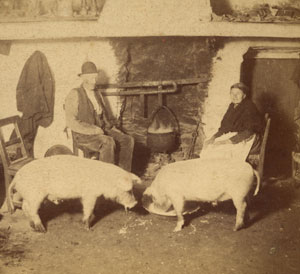Annotation:Pig in the Parlour: Difference between revisions
No edit summary |
m (Text replacement - "garamond, serif" to "sans-serif") |
||
| Line 1: | Line 1: | ||
=='''Back to [[{{BASEPAGENAME}}]]'''== | =='''Back to [[{{BASEPAGENAME}}]]'''== | ||
---- | ---- | ||
<p><font face=" | <p><font face="sans-serif" size="4"> | ||
'''PIG IN THE PARLOUR'''. English, Reel or Country Dance Tune (cut time). F Major. Standard tuning (fiddle). AABB. The melody and country dance directions were first printed in London by music publisher John Walsh in his '''Second Book of the Compleat Country Dancing-Master''', 3rd edition (1735), and in later editions of the same volume. It was also printed by John Johnson in his '''Choice Collection of 200 Favourite Country Dances, vol. 3''' (1744) and by John Simpson in '''The Delightful Pocket Companion, vol. 2''' (c. 1750). London musician Thomas Hammersely entered it into his 1790 music manuscript collection (as "Pig in Ye Parlour"). | '''PIG IN THE PARLOUR'''. English, Reel or Country Dance Tune (cut time). F Major. Standard tuning (fiddle). AABB. The melody and country dance directions were first printed in London by music publisher John Walsh in his '''Second Book of the Compleat Country Dancing-Master''', 3rd edition (1735), and in later editions of the same volume. It was also printed by John Johnson in his '''Choice Collection of 200 Favourite Country Dances, vol. 3''' (1744) and by John Simpson in '''The Delightful Pocket Companion, vol. 2''' (c. 1750). London musician Thomas Hammersely entered it into his 1790 music manuscript collection (as "Pig in Ye Parlour"). | ||
<br> | <br> | ||
| Line 10: | Line 10: | ||
<br> | <br> | ||
</font></p> | </font></p> | ||
<p><font face=" | <p><font face="sans-serif" size="4"> | ||
''Source for notated version'': | ''Source for notated version'': | ||
<br> | <br> | ||
<br> | <br> | ||
</font></p> | </font></p> | ||
<p><font face=" | <p><font face="sans-serif" size="4"> | ||
''Printed sources'': Walsh ('''The Second Book of the Compleat Country Dancing-Master, 3rd edition'''), London, 1735; No. 14. | ''Printed sources'': Walsh ('''The Second Book of the Compleat Country Dancing-Master, 3rd edition'''), London, 1735; No. 14. | ||
| Line 21: | Line 21: | ||
<br> | <br> | ||
</font></p> | </font></p> | ||
<p><font face=" | <p><font face="sans-serif" size="4"> | ||
''Recorded sources'': <font color=teal></font> | ''Recorded sources'': <font color=teal></font> | ||
</font></p> | </font></p> | ||
Revision as of 14:34, 6 May 2019
Back to Pig in the Parlour
PIG IN THE PARLOUR. English, Reel or Country Dance Tune (cut time). F Major. Standard tuning (fiddle). AABB. The melody and country dance directions were first printed in London by music publisher John Walsh in his Second Book of the Compleat Country Dancing-Master, 3rd edition (1735), and in later editions of the same volume. It was also printed by John Johnson in his Choice Collection of 200 Favourite Country Dances, vol. 3 (1744) and by John Simpson in The Delightful Pocket Companion, vol. 2 (c. 1750). London musician Thomas Hammersely entered it into his 1790 music manuscript collection (as "Pig in Ye Parlour").

"Pig in a Parlour" has long been an English metaphor for something out of place, and perhaps unwelcome. So too, if one puts a 'pig in a parlour', it is still a pig (i.e. context does not alter character).
Source for notated version:
Printed sources: Walsh (The Second Book of the Compleat Country Dancing-Master, 3rd edition), London, 1735; No. 14.
Recorded sources:
